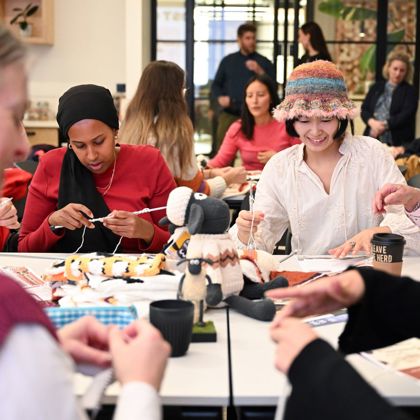Warm Follows Function
Aardman’s Executive Creative Director, Daniel Efergan, discusses the value of humanisation in design, and the emotional engagement it can generate.
Everyone loves Henry. His beautiful dooey eyes, enigmatic smile and long windy nose cheers up the dreariest of household tasks. Henry is, of course, the little red vacuum with the smiley face. It’s been Numatic International’s most successful product, and it seems easy to understand why. First, it’s very good at what it does – no stuck on smile will overcome malfunction – but more importantly it stands out across a sea of boring impersonal lumps of plastic with its personification of product.
The addition of emotion – through tone and visualisation, personification and story – is an essential design consideration of any product these days. If establishing visibility amongst a handful of vacuums 30 years ago was hard, finding visibility within the emerging digital marketplaces of present day is a magnitude more complex. Today there’s hundreds of platforms, thousands of channels, with millions of options. Being useful is rarely enough to cut through this seething mass of potentials, and with such choice available people using a product need a level of feverish fandom above and beyond grudging respect, they need to fall in love.
Love, happiness, joy, and all the other really fun things in life are complex, each a big sticky mess of imperfections, our natural interactions analogue and noisy, our connections warm and personal. And so by adding some of this murky essence, whether instinctively or scientifically, it’s possible to drastically change the way people experience a product.
Personifying an inanimate, or otherwise ‘soulless’ object, instantaneously interfaces with a number of higher brain functions, people experiencing empathy and sympathy into situations where this is technically irrelevant. The simple act of projecting the sense of eyebrows (interestingly more important than eyes) and a mouth onto anything will fire off a person’s instinct to lock onto this visual structure – known as Pareidolia, the psychological phenomenon of finding faces in stimuli – increasing focus and attention, as our hardwired brain kicks in. Similarly, adjust a product’s text to rile its audience with cheeky replies and they will tend towards trusting the information delivered, human-flaws seemingly more believable than something computationally perfect.
Then there’s the art of storytelling, the organic format of information delivery. The academic theories around the formulation of story within our society are numerous, but one in particular is relevant to this discussion; the use of story as a method to transfer complex information from one human to another, in particular emotional content.
As humans, bound by the linearity of time, we are forced to discuss things one comment at a time. Nevertheless, we can also comprehend the most abstract of concepts: love, honour, even nyan cat. These abstract ideas involve a complex interplay between facts; subtleties that would be extremely difficult, or at least exceptionally boring, to deliver as an ordered queue of facts. But, offer up a little of each of these facts, slowly revealing their interconnections, more and more until a glorious and exciting crescendo and we have a tool to successfully communicate complex, emotional ideas – we have the structure of a story.
Armed with these tools of emotional engagement the process of product design sits not as a pure expression of function but also as a series of choices around what to humanise, where to corrupt digital perfection, and how to package content into emotional stories. This is still a design choice, the absence of this as important as the blank space within a visual or the silence within music, but a choice and process to be considered.
At Aardman we find ourselves purveyors of this ‘emotional warmth’, created in its purest form when we invent our films, shows or games – the literal codifying of human emotion into lumps of clay and stacks of pixels. But we also find ourselves working as product designers, adding layers of humanisation to the things we’re building.
Take StorySign, a product which translates the text within children’s books to sign language. Its function enforces the need for a translator, something with human proportions that can ‘sign’. But, it’s more than that, we’re not just creating something, we’re creating someone, a conduit from our product to other people’s imagination. We therefore invested time thinking who is ‘Star’, the virtual signer within StorySign, and what human-like relationship she will have with our young readers.

Also, Nad & Tad, a project created by Nathan Love, our sister studio out in NY. Their personification of two testicles, not only adds a certain charm to the less than desirable conversion about scrotums, but importantly connects us via the very human act of humour, disarming people to allow a way into an awkward conversation.
What we do is not new or original, in fact using our craft to mimic humanity is the oldest form of art. Although I assume, as our industries mature, so does our ability to better mimic the beauty and complexity of the natural world, and in turn our products grow in emotional complexity.
This is a wonderful and powerful thing, but as it’s often said ‘with great power comes great responsibly’. We must understand how design includes this ‘warmth’, but not abuse other people’s emotions. No-one wants a digital future devoid of emotional connection but similarly we don’t want deleting an app to feel like dumping your loved one.
Daniel Efergan is Executive Creative Director of Interactive at Aardman.
If you’ve got a product that needs some warmth and personality added, why not get in touch?
This article is based on a previous article written for the Media Sandbox, provided by Watershed. Illustration by Sarah Matthews.

















